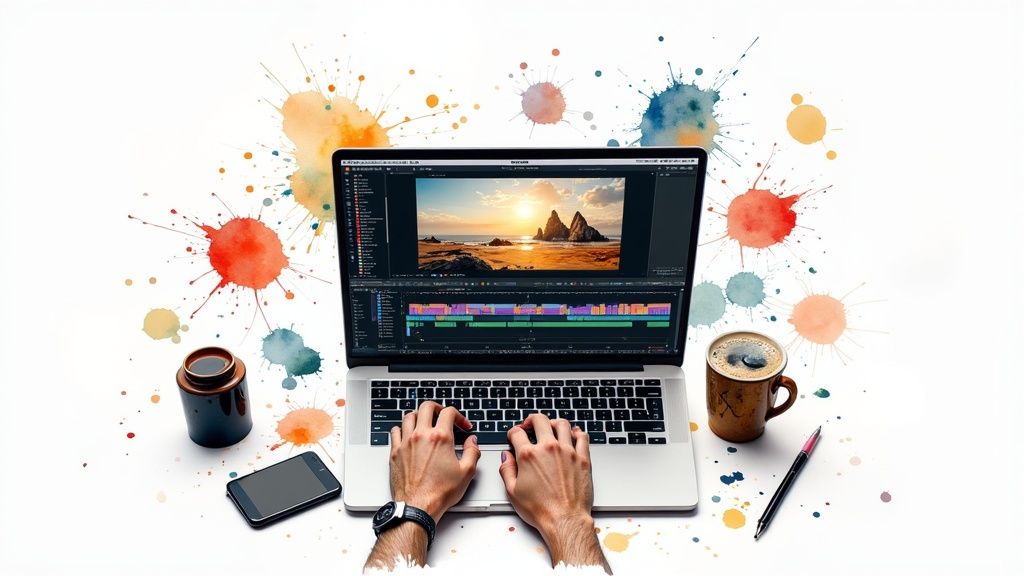The Best Video Editing Software for Social Media in 2024

Video has become the dominant force in social media. Simply posting static images or text updates is no longer sufficient for capturing attention and fostering a thriving online community. Instead, high-quality video content is crucial. This shift means that mastering video editing has become essential for anyone wanting to effectively utilize the power of social media. Consider this: raw video footage is like an uncut gemstone. It holds potential, but it requires the expertise of a video editor, much like a skilled jeweler, to refine and shape it into something truly captivating. That's where finding the best video editing software for social media comes in.
Why is video editing so vital for social media success? Video editing transforms raw footage into compelling content that truly resonates with your audience. Imagine, for instance, you've filmed a product demonstration. Through video editing, you can remove any unnecessary pauses, add text highlighting key product features, incorporate music to enhance the mood, and adjust colors for a professional finish. This process elevates a simple recording into dynamic marketing material. Furthermore, different social media platforms have distinct video requirements. Instagram Reels, TikTok videos, and YouTube content each demand specific aspect ratios and lengths. Video editing software enables you to tailor your videos to meet these requirements seamlessly, ensuring your content looks polished and reaches the broadest audience.
Given the multitude of video editing software options, choosing the right fit can be overwhelming. However, understanding your specific requirements is essential. Ask yourself: do you need basic editing tools for short social media clips or more advanced features for longer, more polished videos? Is your budget limited, or can you invest in professional-grade software? Answering these questions will help you identify the best video editing software for your skills and objectives. In the following sections, we'll explore popular video editing software choices and the essential features to consider.

As mentioned, choosing the right video editing software depends largely on your individual needs and goals. This section will explore some of the most popular options, offering a comparative overview to help you narrow your choices. Similar to selecting the right tool for a particular task, the correct software will streamline your editing process significantly.
For users seeking advanced features and a robust editing experience, professional-grade software is the optimal choice. This category includes industry standards like Adobe Premiere Pro and DaVinci Resolve. Adobe Premiere Pro, with its extensive toolset and seamless integration with other Adobe products, currently holds a 35% market share. It offers a complete range of features, from basic trimming and transitions to advanced color grading and multi-camera editing. However, this power comes with a cost, both financially and in terms of learning curve. DaVinci Resolve, renowned for its high-end color correction capabilities, also provides a surprisingly powerful free version, holding a 15% market share. This makes it a compelling option for those seeking professional features without a substantial financial investment.
If you're new to video editing, user-friendly software like Filmora and CapCut are excellent starting points. Filmora, with a 5% market share, prioritizes ease of use, offering a clean interface and intuitive controls. It provides a good balance of simplicity and functionality, allowing beginners to create polished videos without feeling overwhelmed. CapCut, with a 4% market share, has become particularly popular among TikTok creators. Its mobile and desktop versions offer seamless transitions, facilitating easy editing on the go. With most features available for free, CapCut lowers the barrier to entry for aspiring video editors.
For quick video creation and simple edits, tools like Canva and InShot offer streamlined workflows. Canva, primarily known for graphic design, also provides basic video editing functionality. This is ideal for creating short, visually appealing content for platforms like Instagram Stories. InShot, a mobile-first video editing app, excels at creating engaging content for platforms like TikTok and Instagram Reels, focusing on speed and efficiency.
With so many options, selecting the right software is key. For a more in-depth comparison, you might be interested in How to master social media video editing. Consider your skill level, budget, and needed features. Do you need advanced color grading or 3D animation, or are you simply looking to trim clips and add text? By carefully evaluating these factors, you can choose the software that best meets your unique needs and helps you achieve your social media objectives. In the next section, we'll delve into the key features to consider when making your final decision.
Choosing the right video editing software involves more than just recognizing popular names. It requires careful consideration of features aligned with your specific needs and the demands of social media platforms. Just as a craftsman needs the right tools, a content creator needs appropriate software. This section will outline essential features to look for when selecting video editing software for your social media strategy.
Any effective video editing software should provide a solid set of basic editing tools. This includes trimming and cutting clips, rearranging their order, and adding transitions. Transitions, such as fades and cross-dissolves, ensure smooth, visually appealing shifts between scenes. For instance, a jump cut can create urgency, while a slow fade evokes nostalgia. The software should also allow for simple audio editing, including adjusting volume, adding music, and incorporating sound effects. These basic tools are the foundation of any video editing project.
Since our focus is social media, good video editing software should offer features specifically tailored for these platforms. This means easy resizing for platforms like Instagram, TikTok, and YouTube. Each platform has optimal video dimensions, and your software should simplify adjusting your content accordingly to prevent cropping or distortion. It should also include options for adding text overlays, stickers, and other visual elements common in social media, enabling you to add context, emphasize key points, and enhance viewer engagement. For seamless clipping and cropping specifically for social media, see our guide on Smart Crop for Video.
While basic editing tools and social media optimization are fundamental, advanced features can significantly enhance your content. These include color correction tools to adjust brightness, contrast, and saturation, giving videos a professional appearance. For example, adjusting color temperature can make a video appear warmer and more inviting, while increasing contrast adds drama. This means that even videos shot in suboptimal lighting can be dramatically improved. Some software also provides advanced features like keyframing and motion tracking for more dynamic and creative effects.
Finally, consider the user interface and ease of use. Good video editing software should be intuitive and easy to navigate, even for beginners. A cluttered interface can hinder creativity and make editing frustrating. Look for software with a clean layout, clear labels, and helpful tutorials. This allows you to focus on the creative aspects of video editing, not technical complexities. A well-designed interface makes the editing process more efficient and satisfying. By considering these key features, you can choose the right software and begin crafting engaging content.

As with any task, choosing the right video editing software requires balancing budget and needs. This means understanding the core differences between professional and free options. This understanding is crucial for making an informed decision to support your social media strategy. This section will explore the advantages and disadvantages of each category.
Professional software like Adobe Premiere Pro and the paid version of DaVinci Resolve come at a cost but offer a comprehensive set of tools for creating high-quality content. These platforms provide advanced features like sophisticated color grading, motion graphics capabilities, and seamless integration with other professional tools. For instance, Premiere Pro's Lumetri Color panel allows for precise color adjustments, creating a consistent visual aesthetic. This level of control elevates content beyond basic edits, offering a competitive advantage. However, the cost and steep learning curve can be obstacles, particularly for beginners.
Free options like CapCut, the free version of DaVinci Resolve, and Filmora's free plan provide accessible entry points for content creation. These free tools offer essential functions like trimming, cutting, adding text overlays, and basic transitions, making them ideal for quick creation of engaging content for platforms like TikTok and Instagram Reels. CapCut's intuitive mobile interface enables editing on the go. This accessibility empowers anyone to start creating and sharing video content. However, free options sometimes have limitations, such as watermarks, restricted access to advanced features, or limited export resolutions, which can impact the final product's professional quality. For a comprehensive comparison of both free and paid options, see our article on the Best video editor for social media.
Ultimately, the best software depends on your specific needs and goals. If you're a professional with a dedicated budget, professional software provides power and flexibility. If you're starting out or seeking a simple way to create basic videos, free options are a great starting point. Consider the complexity of your edits, the frequency of your video creation, and the importance of professional polish when making your choice. By weighing these factors, you can select the software that best supports your social media success.

Choosing the right video editing software also requires understanding the unique needs of each social media platform. Much like tailoring clothing to different occasions, a video optimized for YouTube won't necessarily suit Instagram Reels. This section explores the platform-specific requirements to ensure your videos look their best and reach the widest audience.
Different platforms have preferred video dimensions and aspect ratios. YouTube favors landscape videos with a 16:9 aspect ratio, the standard widescreen format. Platforms like Instagram Reels and TikTok, however, prefer vertical videos with a 9:16 aspect ratio, reflecting how people hold their phones. Using suitable video editing software allows you to adapt your videos to these different dimensions, preventing cropping or distortion. This detail can significantly impact how professional and engaging your videos appear.
Video length limitations also vary across platforms. YouTube, designed for longer content, allows uploads exceeding hours in length, which is ideal for detailed tutorials or vlogs. However, platforms like TikTok originally limited videos to 15 seconds, later expanding to accommodate up to 10-minute videos, encouraging shorter, attention-grabbing content. Instagram Reels followed a similar path, increasing its limit from 15 seconds to 90 seconds. The best software will offer tools to easily trim videos to the appropriate length for each platform.
Finally, your video editing software should address file size and format requirements. Some platforms accept larger files, while others have limitations that affect upload speed and quality. You might need to compress your video file to meet platform requirements. Most prefer the MP4 format for its balance of quality and file size. Good video editing software will offer export settings tailored to each platform, ensuring smooth uploads without sacrificing quality. By understanding and adapting to these platform-specific needs, you can optimize your videos for social media success.
Choosing the best video editing software is akin to selecting the right instrument for a musical piece. Each software offers unique features, and the right choice hinges on the content creator's specific needs. This post has explored a range of options, from professional-grade software like Adobe Premiere Pro and DaVinci Resolve to user-friendly options like Filmora and CapCut. We've also examined key features, including basic editing tools, social media optimization features, and advanced capabilities. This means whether you're a seasoned pro or just beginning, you now have the knowledge to choose software that aligns with your skills and budget.
We also delved into the distinctions between professional and free software. Professional software offers extensive features and power, while free software provides an accessible entry point for beginners. Finally, we stressed the importance of understanding platform-specific requirements, including variations in video dimensions, length, and file size. The best video editing software will enable you to tailor content to each platform, ensuring it resonates with your target audience.
Ready to streamline your social media video creation workflow? Aeon is a powerful, AI-powered video creation platform designed for publishers. From automating video production to optimizing for social media, Aeon offers tools to create engaging video content with minimal human intervention. Learn more about Aeon and how it can transform your social media strategy.